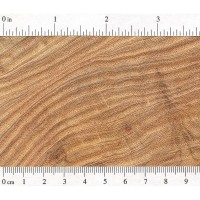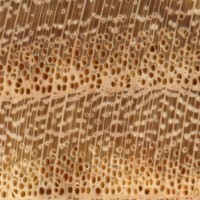 |
Common Name(s): Honey Locust Scientific Name: Gleditsia triacanthos Distribution: South-central and eastern United States Tree Size: 65-80 ft (20-25 m) tall, 2-3 ft (.6-1.0 m) trunk diameter Average Dried Weight: 47 lbs/ft3 (755 kg/m3) Specific Gravity (Basic, 12% MC): .60, .75 Janka Hardness: 1,580 lbf (7,030 N) Modulus of Rupture: 14,700 lbf/in2 (101.4 MPa) Elastic Modulus: 1,630,000 lbf/in2 (11.24 GPa) Crushing Strength: 7,500 lbf/in2 (51.7 MPa) Shrinkage: Radial: 4.2%, Tangential: 6.6%, Volumetric: 10.8%, T/R Ratio: 1.6 |
Color/Appearance: Heartwood is a medium to light reddish brown. Wide sapwood is a light yellow, clearly distinguished from the heartwood. Very similar in appearance to Kentucky Coffeetree.
Grain/Texture: Grain is usually straight or slightly irregular, with a medium uneven texture. Moderate natural luster.
Endgrain: Ring-porous; 3-5 rows of large to very large earlywood pores, medium to small latewood pores commonly arranged in tangential bands; tyloses absent, other reddish heartwood deposits occasionally present; growth rings distinct; medium to wide rays visible without lens, wide spacing; parenchyma banded, parenchyma vasicentric, and latewood is commonly lozenge and confluent.
Rot Resistance: Rated as moderately durable to durable; susceptible to insect attacks.
Workability: Honey Locust can be difficult to work with hand and machine tools on account of its density, though it generally produces good results. Turns, glues, stains, and finishes well.
Odor: No characteristic odor.
Allergies/Toxicity: Besides the standard health risks associated with any type of wood dust, no further health reactions have been associated with Honey Locust. See the articles Wood Allergies and Toxicity and Wood Dust Safety for more information.
Pricing/Availability: Not widely or commonly available, limited quantities of Honey Locust are sometimes available within its natural range. Prices are likely to be in the mid to upper range for a domestic hardwood.
Sustainability: This wood species is not listed in the CITES Appendices or on the IUCN Red List of Threatened Species.
Common Uses: Furniture, fence posts, utility lumber, and turned objects.
Comments: Somewhat similar in appearance to Black Locust, Honey Locust is technically in a different genus, (Robinia and Gleditsia, respectively), and telling the two apart is somewhat similar to separating White and Red Oak—the pores of Black Locust are packed with tyloses, while they are absent in the pores of Honey Locust. Honey Locust bears a much closer resemblance to Kentucky Coffeetree, which is similar both in color, grain, and anatomy. The latewood pores of Coffeetree tend to be in circular clusters, while they are usually arranged in tangential bands in Honey Locust, being connected by confluent parenchyma.
A related species, Water Locust (Gleditsia aquatica), grows in swamps in the southeast United States, and has similar wood properties and anatomy.
None available.
Scans/Pictures: A special thanks to Mike Leigher for providing the wood sample of this wood species.








I have about 200 board feet of Honey Locust from trees that grew in the courtyard of my local church. I volunteered to make 4 garden benches from this material. I want to know if I should seal the wood for the seasons. Any recommendations
It will need to be sealed as it is not built like white oak. However an oil seal (mineral oil mixed with UV resistant urethane) does a great job for a very long time. It changes the color of the wood to a light honey-Amber color. Tends to look like a mahogany as it darkens over time.
Honey locust fluoresces under blacklight!
I have a customer who has one of these trees that I’m supposed to cut down. Two questions. …. 1) cutting it down say compared to an oak tree , is it hard as oak? Like will it be difficult to cut up ?
2) Would the trunk sections be worth keeping to sell or milled for like woodworking?
Had a big one cut down recently. No problem with the cutting but be aware, the cleanup is a pain! The branches are brittle and break into thousands of small pieces which take a lot longer to clean up than big intact branches. Ended up paying the crew a bit extra because the bid didn’t take all that extra time into account.
Before you cut down a Honey Locust, use a pole saw to cut off as much of the trunk spikes as you can. These thorns will give your vehicle and trailer a flat. It is harder than oak, but not difficult for a chain saw. (Janka Hardness: Red Oak,1290; Honey Locust, 1580.) Upon felling, cut the branches off and cut off the remaining trunk thorns. You can run the small branches through a chipper or use for firewood. It burns really hot. Use tough leather gloves and take care in handling. The branch thorns can be brutal. The grain of… Read more »
Good day everybody how are you question when using a moisture meter on honey locust what setting should it be .60-.70
I chainsaw milled one a couple of years ago and about halfway through I discovered and ant colony (99% sure it’s carpenter ants). I didn’t mill any more but I did take what I had milled and power washed all the bar and chain oil along with everything else off and then set it out to dry, I placed ant poison underneath the wood stack to kill any remaining ants well it dried for a couple years. i didn’t see any ants AT ALL after the power washing. About 3 or 4 months ago I brought pretty much everything inside… Read more »
That is a big mystery. I don’t know if there’s any truth to this, but I’ve heard that carpenter ants can sense the moisture in the wood, and survive by drinking the sap from the wood. Only a queen ant can survive more than a few months, so your larger ant was definitely a queen. With limited resources, she would not have been able to sustain a large colony, but they don’t actually need light, so as strange as it is, I would say it’s plausible.
The only insect problem I’ve seen are termites under the bark, but they do not enter the heartwood.
Hello and thank you for having this site.
I did want to point out that honey locust trees are terminate and insect resistant (very) due to chemicals contained within the tree and in fact many places/countries are using it instead of where treated wood is used…
I’d say it has mild to strong odor when freshly cut. To me, it reminds soar wine or fruit vinegar.
Your description sounds more like black locust, possibly a thorned black locust. My honey locust smell like carrots but they’re as wet as peeled cucumbers where my chain debarks this early in spring.
I have black locust wood too (cut down by electricians on the street and shared with the neighbour). Now, after four and a half years, it smells completely different when resawed, though I did not try it when freshly cut. As per my honey locust, this little one was cut two-three years ago and lied neglected near my office all that time until I noticed, with some damage made by fungi. Though I first removed all discolourated parts, before resawing “good” portion, it is plausible that I am mistaken and this wine-like smell (belonging to “good” parts) arose because of… Read more »